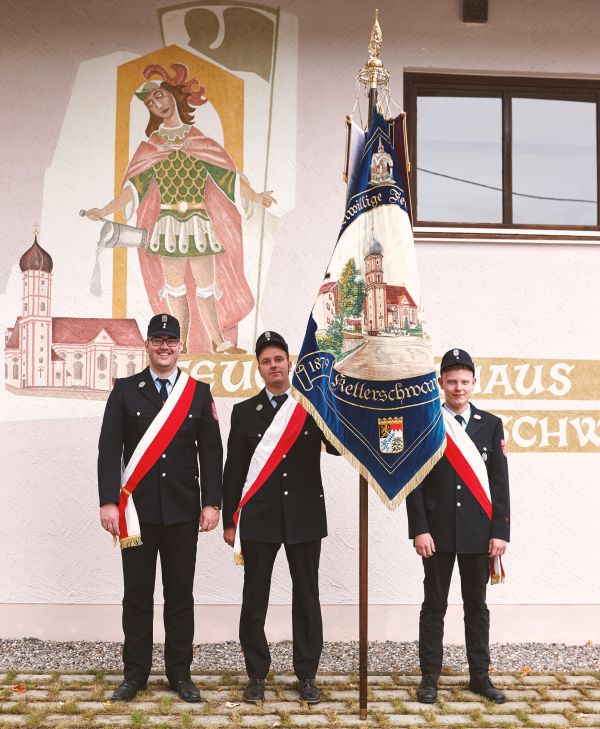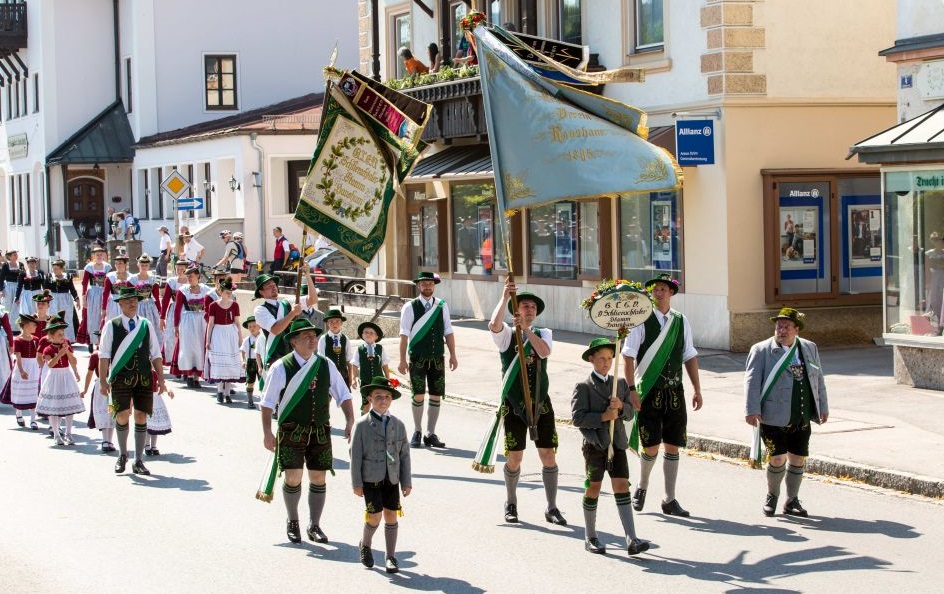Fahnen Kössinger, June 28, 2016, 01:18 p.m.
How do you carry a flag correctly?
The flag is a continuous source of pride for each club - it is the symbol for the community, consecrated mediator between the generations, and it often accompanies its members for decades. It is a special honor to be allowed to carry this precious piece during parades, procession, and church services - but it also includes a lot of responsibility. The flag ensign is mostly supported by two attendants.
It goes without saying that the bearer has to take care of his or her appearance. If a sash belongs to this, it is carried with the white side near the neck. The companions wear the sashes off of the flag - the one on the right side of the flag carries it on the left shoulder and vice versa. If a hat is part of the costume, it should be equipped with a hat cord out of practical reasons. The cord allows the hat to be kept on during a church service while otherwise, men are supposed to take off their headwear in church.
The ensign's task starts with fetching the flag from its storage place and ends when it is again put away properly. The first thing to take care of is to check whether all parts of the flag are in order - flag fabric, finial, flagpole, carrying strap, and bannerring. In bad weather, a protective cover must not be missing. The ensign is also in charge of loading the flag for transport in an orderly way. Specialists recommend to not simply roll the flag fabric around the pole but to fold it diligently and transport it in a suitable bag. Fabric and embroideries may suffer damages quickly when, for instance, metal parts get stuck together or the different layers of fabric are distorted. On reaching the destination, the flag bearer assembles the flagpole together with his companions and attaches banners and ornamentation. On the way to the meeting place, the flag may still be carried over the shoulder - it is however important that it won't touch the ground and gets dirty.
The ensign's task starts with fetching the flag from its storage place and ends when it is again put away properly. The first thing to take care of is to check whether all parts of the flag are in order - flag fabric, finial, flagpole, carrying strap, and bannerring. In bad weather, a protective cover must not be missing. The ensign is also in charge of loading the flag for transport in an orderly way. Specialists recommend to not simply roll the flag fabric around the pole but to fold it diligently and transport it in a suitable bag. Fabric and embroideries may suffer damages quickly when, for instance, metal parts get stuck together or the different layers of fabric are distorted. On reaching the destination, the flag bearer assembles the flagpole together with his companions and attaches banners and ornamentation. On the way to the meeting place, the flag may still be carried over the shoulder - it is however important that it won't touch the ground and gets dirty.


During the parade itself, the flag is carried upright. It leads the club, behind it, the rest of the members walk in a row. When the parade passed the honorary tribune, the flag is taken out of the quiver and swung forward so that there remain about 25 cm between flag fabric and ground. At the finishing point of the parade, the flag ensigns often place themselves in a row. In this case, the flag with the highest rank - normally that of the organizing club - is on the first place, then the other flags besides it. The flag itself is kept vertical, the flagpole stands besides the right foot. If high representatives or other clubs are marching by, the flags are being lowered slightly to the front with the extended right arm.
There are some things to pay attention to also during church services. On entering the church, the flag is carried with the finial to the front while neither fabric nor banners are supposed to touch the ground. Afterwards, the flag bearer goes to the altar, lowers the flag once and then places himself besides the other ensigns. The flag is kept upright during the service, the pole is placed besides the right foot. Only after the transubstantiation, the song "Großer Gott" and during the final blessing, is it lowered. After the service, it is again lowered in front of the altar, before the flag delegations leave the church.
There are also special rules during bereavements. Often, clubs do their deceased members the honor, and the flag is carried to the cemetary. When the coffin is lowered into the grave, the flags are being lowered as well. This also applies when the song of the "Alte Kamerad" is being played or when wreaths are laid down. To do the honor to the deceased, the ensigns near the grave as last ones when the priest steps back and tilt the flag three times.
back to the blog survey >
There are also special rules during bereavements. Often, clubs do their deceased members the honor, and the flag is carried to the cemetary. When the coffin is lowered into the grave, the flags are being lowered as well. This also applies when the song of the "Alte Kamerad" is being played or when wreaths are laid down. To do the honor to the deceased, the ensigns near the grave as last ones when the priest steps back and tilt the flag three times.
back to the blog survey >

 English
English  Deutsch
Deutsch